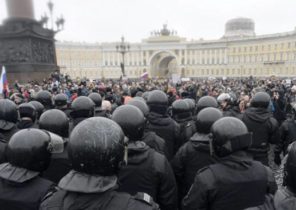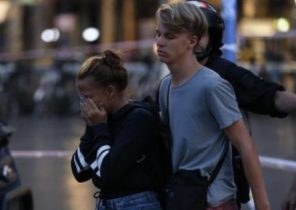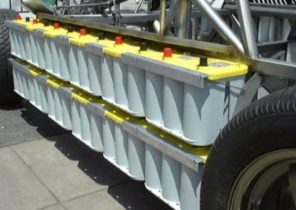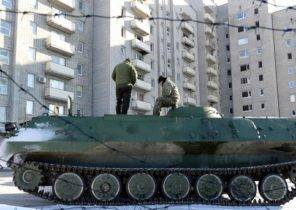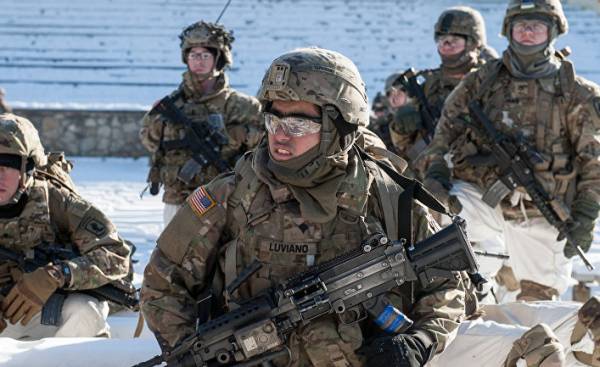
In response to the Russian annexation of Crimea, NATO sends in its East wing (to the Baltic States and Poland) and four thousand soldiers. Moscow is dissatisfied and makes a full of resentment of the statement, is aimed primarily at the domestic audience: “You want to drag us into a conflict, you place military forces directly on our borders”. But what is actually the balance of forces on the imaginary line of contact?
Approximately four thousand soldiers consisting of four multinational battalions, which are gradually placed in the Baltic republics and Poland to deter Russia, are actually just a sort of symbolic gesture, designed to reassure allies on the Eastern border. Especially if theoretically compare this reinforcement with those powerful forces who are “asleep” on the opposite side.
Statements by Russian leaders about “if they wanted to”, then for a few hours could seize Tallinn, Riga and Vilnius, is not so — in regard to the correlation between the military forces of the two parties is far from reality. Indeed, in this region of Russia has a two-fold advantage.
It should be emphasized here that in this article, based on dozens of sources, compares the data only on the regular armies of different countries, and are not considered a paramilitary, volunteer or mobilized strength as well as power supply.
According to the annual statistics of the North Atlantic Alliance in the past year, Estonia, Lithuania, Latvia together provided 23 900 troops. And in areas adjacent to those of the Baltic countries and regions from the Russian side posted 65 thousand soldiers of the Western military district.
The entire Russian Western military district, extending to the North along the borders of Norway, Finland, Baltic republics, Belarus, and Ukraine up to the Kursk, according to the standards of the Russian Ministry of defense formally should include 400 thousand troops. But in fact, their numbers below.
Says Russian military analyst Andrei Frolov of the Moscow center of the CAST (The Centre for Analysis of Strategies and Technologies), for the defence of the most densely populated part of Russia (with Moscow) in fact meets the 250 — 300 thousand soldiers. Analyst Anna Maria Dinarov of Polish Institute PISM in his latest report of last year’s leaning to more.
Anyway, in this County, whose command is located in Saint Petersburg, 2 parts of 500 deployed nearly 40% of the Russian armed forces.
Two of the strategic fleet and the Kaliningrad
Russian Western military district was formed in September 2010 by presidential decree, by merging the former military districts — Moscow and Leningrad. The prestigious British think tank Chatham House, writes in his analyses that, in the Western district of the Russian command has 850 artillery, tanks 320 and 750 combat aircraft.
Not the last role play and the two battle fleet, passing the modernization of the Northern fleet base in Severomorsk in the Kola Bay of the Peninsula and disproportionately smaller Baltic fleet in the Russian enclave of Kaliningrad.
Kaliningrad oblast — a separate conversation. This area was a medieval stronghold of the crusaders along with the city called kralovec in honor of the Czech king Premysl Otakar II, who stood at the head of the army of crusaders during one of the Crusades against the Prussians, the former pagans, and then became the capital of East Prussia königsberg. During the cold war because of its strategic position, this area was probably the most militarized section of land on the planet. There were up to 200 thousand Soviet soldiers.
A small area at the mouth of the river Pregel flows into the Baltic sea wedged between Lithuania and Poland. Currently, to obtain accurate information about the Russian armed forces in this region impossible. In 1999 the defense of the Kaliningrad region consisted of 850 tanks, 550 rocket launchers, 350 artillery systems, 99 ships, including six submarines, more than 180 combat and transport aircraft and helicopters, as well as 25 thousand soldiers.
Today, according to some estimates, there are about ten thousand soldiers, and during major exercises — up to 30 thousand. Recently, however, Russia has deployed in Kaliningrad region mobile missile complex “Iskander”.
These missiles can carry nuclear warheads and have a range of 500 kilometers, meaning they can strike almost any place in Poland. Shield create the most advanced Russian air defense systems s-400, which would make this small region in the event of a conflict in a virtually impregnable zone to NATO allies when they rushed to the aid of the Baltic members of the Alliance. In addition, in the Kaliningrad region is a powerful radar station “Voronezh-DM” with a detection range of more than six thousand kilometers. This radar is able to monitor the whole Europe.
Now Russia has a two-fold advantage
So, at this point in the Western military district and Kaliningrad, Russia has a total of 260 — 310 thousand soldiers. Compared to this, the Baltic States and neighboring Poland, which borders with the Kaliningrad oblast, and which, naturally, first rushed to the aid of the Baltic republics, have a little less than 130 thousand soldiers. So Russia has a double superiority.
But the plans of the Alliance of Polish forces play a key role. This is about protecting the so-called region of suwałki. The region around the city from the point of view of defence of Poland and the Baltic States is strategic. Approximately one hundred km border corridor from Poland to Lithuania also shared by Belarus and the Russian Kaliningrad and are therefore important for logistics and military assistance to Lithuania and other two Baltic republics.
“Russia has strengthened its army in the Western and southern districts. This was done not only in reaction to the NATO decision, which strengthens its Eastern wing, but also from strategic considerations. Russia’s actions also are a challenge for Ukraine and Belarus, because Russia is increasing the size and power of their units near the borders of these States. Russians are increasingly using military superiority to achieve political goals in Eastern Europe, and NATO is a serious challenge,” stated Dinarov from the Institute PISM.
International sending four battalions in response to the Russian annexation of Crimea a total population of four thousand soldiers in the Baltic States and Poland, it seems, when compared with the “dormant” overseas forces, funny. But it sent a clear message: NATO is unified, and the attack on any member is considered an attack on all. So the battalions have a multinational composition. The United States will lead the battalion in Poland, Germany, Lithuania, UK, Estonia, and Canada — Latvia.
“Despite the statements of the Kremlin, these steps are adequate and symmetrical,” said former Deputy Secretary General of NATO Alexander Vershbow. According to him, seeming at first sight insignificant forces directed to the East wing, this is a clear proof of Alliance solidarity and resolve to defend the territory against possible aggression.
Moscow outraged and spreading disinformation
Already the plan of the Alliance to send in their East wing, some forces in Moscow strongly condemned. Last summer before the NATO summit in Warsaw, where the allies agreed to send four battalions of the Russian state media was full of reports of dangerous placing forces close to Russian borders.
There was also the misinformation. For example, the Russian state TV channel Russia Today in its “corrected” data of the Western news agencies about the alignment of forces in the Baltic States. In the Russian Western military district, the TV station counted a total of 30 thousand soldiers and a strategic Kaliningrad and is not included.
Since then, the Russian media present the situation is practically the same. “Over the past few years the US and its NATO allies gradually built up its forces in Eastern Europe to a level not seen since the cold war,” wrote, for example, in January the propaganda Sputnik server.
Recently, the deployment of four battalions in the Baltic States sharply criticized Deputy foreign Minister Alexei Meshkov, according to which, near the Russian border increases the threat of different kinds of incidents. Therefore, serious negotiations with NATO on European security is supposedly possible only after in Eastern Europe, everything will return to its original state. “This placement is, of course, is a threat to us,” said Sacks.
But the Alliance is constantly repeats that he went to these measures, responding to Russian actions in Crimea and Ukraine, and taking into account the concerns of the Baltic States, which are home to large Russian minorities and which fear that they may suffer the fate of Crimea.
While Moscow accuses NATO of breaking important parts of the Founding act on relations Russia — NATO from 1997. In it, the allies promised that they would refrain from the “permanent placement of substantial combat forces” on the territory of new member countries, but instead will build on and strengthen their own forces in these countries. Before the Ukrainian crisis the only explicit element of the armed forces of the Alliance to new member countries was a fighter, designed for patrol and protection of the airspace of the Baltic States.
According to the former Deputy Vesbo, which in the 90-ies was personally involved in the negotiations with Moscow from the Americans, the parties have not agreed on a clear definition of “substantial combat forces”.
“But Russia at that time was officially proposed limit — one brigade in each country. These four battalions in four countries, plus an additional U.S. forces for bilateral agreements it is far from proposed restrictions,” said Wishbow. Therefore, any allegations of breach of the Founding act, he, in his own words, he was lying.
The Kremlin puts on the chessboard of the new piece
Russia responded to dispatch four battalions in their own way and even before the allies finally agreed in July of last year. First, the Supreme command decided to restore the 1 Panzer army, which was formed from the 2nd Taman guards mechanized and 4th guards Kantemirovskaya tank division. “A new army is able to neutralize the threat of the Baltic countries”, — wrote the Russian Internet-newspaper “Zvezda” coordinated by the Ministry of defense.
In may, the Russian defense Minister Sergei Shoigu said on the strengthening of the units on the Western border at the expense of three more divisions, and thus the total number of troops will amount to 30 thousand. Each of the new divisions will consist of six regiments to serve in the state of full combat readiness. “The new Russian division will be the hammer that will break any defense,” wrote army server.
These units also received pre-emptive right to re-and the first in the Russian army has received the most modern tanks T-14 “Armata”, self-propelled howitzers 2С35 Coalition-SV and armored vehicles “kurganets-25”. In the South 150 mechanized division will be located in Novocherkassk, Rostov region. In the West, the 10th Panzer division in two cities of Voronezh and Belgorod region, and has not received the rooms division will be located in Smolensk region at the border with Belarus.
Two divisions, therefore, will be part of the Western military district. “Moscow considered that the axis Berlin — Moscow remains in force, so Russia just in case, better to have a considerable force in readiness on the spot now. Russia has always relied on brute force,” said security expert and former chief of the General staff of the Czech Republic jiří šedivý.
One of the divisions will be included in the southern military district. In it, according to Andrei Frolov CAST for 2014, 72 deployed thousands of soldiers. But the question remains, how many of them were deployed on the annexed Peninsula of Crimea. According to various sources, now there may be up to 40 thousand troops.
“These figures may be exaggerated, but it is undeniable that the contingent of Russian armed forces on the Peninsula has increased significantly. And it’s not only about the number of soldiers, because the Russian in the Crimea is placed and a large number of modern weapons, such as ballistic missiles “Iskander”, the su-35S and Tu-22M3. Among these systems, of course, includes carriers of nuclear weapons, but Russia is the most important that the control of Crimea means better control over the coast and the Black sea,” said a military journalist Lukasz Vikingr.
Rapid reaction force, apparently, would not be enough
It is clear that in the event of hostilities with Russia, although they are very unlikely, all three Baltic States there would be “no chance”, and their existence would depend entirely on the assistance of allied countries. “In quantitative terms, the buildup of forces due to the four battalions placed special does not matter — it is only the symbolic expression of support,” said šedivý.
However, he added that if “the clouds will thicken” the Alliance is ready to send to the Baltic States much more numerous reinforcement. “Then the balance of power gradually, but significantly changed,” said jiří šedivý.
In case of crisis NATO has 40 thousand soldiers of the rapid reaction force, of which five thousand (super-fast response Force — VJTF) is able to come to the rescue in jeopardy the country within a few hours. Also in this case one would expect the massive aid of the United States who are able, like Russia, in a very short time to transfer the thousands of soldiers in the distance.
According to data compiled by the International Institute for strategic studies (IISS) in London, officially the NATO forces in Europe far exceed the strength of the Russian West and South County. “If in the Baltic States sparked a long conflict, the Alliance would have huge reserves in terms of personnel and in terms of equipment”, — stated in the analysis of the IISS.
According to official data, the 26 European members of NATO have almost two million soldiers, seven thousand tanks, thousands of 11 guns and more than two thousand aircraft.
However, in this regard, the authors of the analysis draw attention to the fact that the data distorts the very Turkey. It on one account for a quarter of military personnel of NATO and one-third of the total number of tanks. As for Russia, it has about 800 thousand soldiers.
But, according to Lukas Wisinger, in recent years, the level of operational readiness of the Russian army, no doubt, have risen sharply. Vising believes that if we leave aside legal and moral aspects, from a purely professional point of view, the operation in Crimea, the actions in Eastern Ukraine and intervention in Syria are a very successful military operation.
“The biggest contribution was made by defense Minister Sergei Shoigu, one of the most talented people in Putin’s entourage and, according to many experts, his likely successor,” said Wisinger, noting the frequent introduction of unannounced inspections of combat readiness of the Russian army, as in the jargon is called large-scale military exercises.
“The correct response to this is there is only one. NATO countries just have to learn to do the same. Russian political culture respects, primarily power, but since the majority of European politicians only able to make meaningless speeches and complain about how unfair and aggressive Russia, then we should not be surprised that Vladimir Putin did not take them seriously. To equal the Russian will stick with someone who will understand that with him in these games can be played absolutely equivalent”, — said Vikingr.
